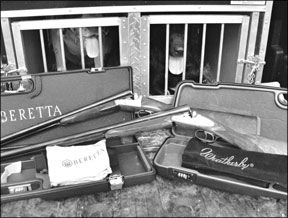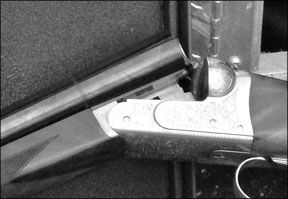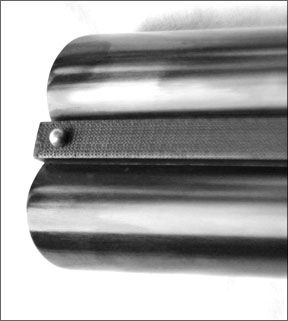Like most other American shotgunners, Gun Tests shooters often express an appreciation for the beauty of the side-by-side. It takes almost nothing to fall in love with a London best-until you start looking at price tags and the waiting times to get one even if you could afford one. The reason for what is usually viewed as exorbitant pricing for famous-label makers such as Purdey, Holland & Holland, and others is actually well founded. Not only are these guns hand made, hand finished, and hand engraved (which is why it also takes years to get one if you can pony up the cash), but it has always been harder, and thus more expensive, to regulate two barrels on a horizontal plane to shoot to the same point of impact than it is to do the same with vertically arranged tubes.

These factors add up to a need-to-win-the-lottery aspect, and it is what keeps most average Joes, and that includes us at Gun Tests, from looking beyond our pumps, semi-autos, and over/unders.
Truthfully, the advent of improved machining has shaved the prices down on many side-by-sides over the decades. Witness the quality guns of Spanish origin that dont come close to having five figures (or more) to the left of the decimal point. Yet you still dont see them sitting on retailer shelves, in no small part because there are more than a few makers and they dont have the name recognition that lends confidence to the casual buyer (i.e., you need to do some homework to buy one). Instead, many buyers will tend to buy better-known names, such as Weatherby and Beretta.
With that in mind, we recently tested two affordable side-by-sides, the Weatherby Athena DItalia ADX1228SGM, $2925, and the Beretta 471 Silver Hawk J471210, $3625.
We trotted these two field guns over several rounds of sporting clays and skeet. For accuracy, we also shot both guns standing at 40 yards and from the Shooters Ridge Steady Rest on Midway USAs MTM portable shooting bench. We fired these point-of-impact tests on the National Target Companys shotgun patterning target, and learned both guns were accurately regulated. We used an RCBS trigger-pull gauge provided by Midway USA to measure the trigger pulls on both guns barrels, and otherwise shot the heck out of them.
Heres how the pair measured up in our testing:
Beretta 471 Silver Hawk
J471210 12 Gauge, $3625
Weve noticed a distinct improvement in the fit and finish of Berettas guns lately, and the 471 Silver Hawk was no exception. Our sample sported a well-figured piece of wood, dark chocolate in color. The buttstock sported a classic orange butt pad mated to a black spacer that marked a smart-looking transition from wood to pad. We liked having this pad as a feature on this gun. Too many times, makers seeking to keep a classic design classic achieve such looks by denying modern improvements. We would not have been surprised to have received this gun with a finished, checkered wood end to the buttstock. But such aesthetics, while handsome, arent terribly practical. With the many technical fabrics that we have available these days to keep us warm and dry while hunting, a buttstock minus some sort of tacky (as in gripping, not cheap) butt pad has a tendency to slip from the shoulder during firing. A rubber butt pad, of course, eliminates such a problem. That Beretta put an orange one on this stock-and fitted it perfectly-was the touch we feel was needed to combine the practical with the classic. However, the Beretta website indicates that this gun

can also be ordered with a black-rubber butt pad, as well as a hard-plastic butt plate.
The wrist of this English-stocked gun was trim and provided ample room for a variety of hand sizes. It was also beautifully checkered on both sides in a tight, fine pattern that extended from just below the safety past the point of the elongated trigger tang. There also appeared a small diamond inset of checkering at the top of the wrist just to the front of the comb drop-off.
The buttstock was fitted nicely to the receiver. We found the inletting to be identical on both sides of the boxlock receiver and around the trigger guard inset. It was wonderfully finished around the extended trigger guard tang, with an almost seamless flush mount that nearly defies a fingertip run down it to define where the metal ends and the wood begins. This fine wood-to-metal fit was echoed on the splinter forend with its Anson push-type release, and the forends wood itself was a beautiful match to the buttstock both in figuring and color. (By the way, Berettas website notes this gun can also be ordered with a beavertail fore-end if you order the gun with a pistol grip, and if the websites pictures are indication, its nearly as graceful in appearance as the splinter on our sample.) The forend also sports wrap-around checkering, as well executed as it was on the buttstock, and a small metal, diamond-shaped insert that conceals the set screw of the forends guts was a nice visual addition.
We were impressed with the receiver detail. Forgoing false sideplates, Beretta instead scalloped/beveled the receiver sides for a bit of added texture, then provided nearly full coverage of an oak leaf pattern on the sides and bottom. The fences, too, sport the oak leaf pattern, but get further enhancement with a floral motif at their insides, which transition nicely to the flower centering the top lever swivel point.
The top lever itself had a small gold inlay of a hawks head, and the top tang had a bit of stitching-like engraving running down its sides from the fence rears to the safety top edge. The only real flaws we spotted were the slightly off-center alignment of two of the three screws holding the trigger assembly into place. We found no flaws in the finish of the barrels, which are of a monoblock design and with laser-fused lumps.
Mechanically, the safety was typical of Beretta, being of a forward/back engagement, with a side-to-side barrel selector integrated in the middle. We like very much that Beretta added an extra bump to the barrel selector of this single-selective-trigger gun, making for easy thumb identification and activation.
The top lever, on the other hand, we wish had been of a stay-open design. That its not adds frustration to the gun assembly process because it forces the user to keep the lever shoved hard to the right while engaging the lugs over the hinge pins and then swinging the barrels up to lock them into the block.
The assembly may very well have been the only awkward feature of this gun, for the Beretta 471 Silver Hawk was a delight to shoot. Its weight was squarely between the hands. It was fast on zippy targets, and yet controllable on long crossing presentations. In all, the gun equipped with its 28-inch barrels swung beautifully. The small, single silver front sight bead was just enough to provide some guidance in acquisition. We actually wouldnt have minded a slightly larger-diameter bead because the non-serrated rib on this gun was very low in profile. Recoil was certainly manageable-we had no issues with shot-to-shot recovery, even with the heavy target loads from Remington that we employed for the test.

We initially thought this gun shot a bit high, but after our testers fished around with their fore hand placements and brought them back a bit (hand cupped under the barrels with the pointer finger resting on the underside of the Anson release button for consistent placement), yet not enough to feel that the fore hand was unnaturally too far to the rear (i.e., it didnt cramp up the swing), the gun was spot on.
That brings us to believe that while nearly everyone will enjoy shooting this gun, taller shooters will probably want to have an additional spacer or so added at the back end to lengthen the stock and/or perhaps change the pitch a bit. Shooters of medium height, say in the 5.5- to 5.8-foot range, and women of average height and shorter in particular, we think will feel comfortable with the fit of this gun out of the box.
We experienced no mechanical failures to fire from barrel to barrel, regardless of the order in which they were fired. The ejectors worked without incident. A neat feature of this gun was the availability to change from ejector to extractor. A switch to the lower inside left of the forends inside was marked “M” for manual (extractors only) or “E” for ejectors. For those who dont like their shells flying all over Gods creation while theyre hunting, we think theyll appreciate this feature on the Silver Hawk.
The Silver Hawk also employs an auto-safety feature upon breaking the gun, a feature we appreciate having on a shotgun intended for shooting live birds. (A manual safety is available for order.) Further safety was incorporated via the guns hammer blocks, which prevent discharge if the firearm is dropped.
We were also impressed with the quality of the breaks from this gun, even at significant distance using the modified and full-choke tubes. Beretta includes five Mobil chokes with this gun. In addition to the two we used on shooting courses, we were also supplied with cylinder, improved, and improved modified choke tubes. Just like with the rubber butt pad, we give points to Beretta for recognizing the modern benefits of removable choke tubes.
Weatherby Athena DItalia
ADX1228SGM 12 Gauge, $2925
This venerable and completely American company has always had a well-earned reputation for its quality rifles, but it has often struggled in the shotgun market. The company came out of some of that slump when it totally overhauled and reintroduced its semi-automatic SAS a few years back. But you dont see its double-barreled offerings often, either in the field or on the sporting-clays course.
Weve tested some and like them just fine, and look forward to retesting some of their models now that SKB is no longer making them (both the over/under and side-by-side offerings from Weatherby are made by the Italian firm Fausti Stefano). The side-by-side models are relative newcomers to the Weatherby fold, though, being introduced just two years ago.

Our sample sported a nicely figured, caramel-colored buttstock that matched its Anson-release forend. The wood was oil-finished, and while we noticed one point on the right side of the stock where a divot in the grain had been puttied, it was finished well and did not detract from the quality of the finish. Both the buttstock and the forend exhibit what Weatherby calls a New Scottish checkering pattern. Our test shooters adored it. A tight 20-lpi pattern with what we can only describe as a “welted” look to its diamond-spaced cross-hatching, it was beautifully unique to look at and offers good purchase to the hand, both gloved and ungloved. It was superbly executed, in our opinion.
The Athena DItalia scored points in other areas as well, and many of those were similar to the Beretta. We liked that a rubber butt pad was installed on the Weatherby, this one in black with a black spacer that looks just fine, and we likewise appreciated the removable choke tubes, though we wish Weatherby had included skeet and improved modified constrictions in addition to the improved, modified, and full chokes it did supply.
This gun scored extra points for style. With false sideplates in full-coverage Acanthus scroll-style engraving enhanced with ribbon-like detail, the Weatherby was every bit as handsome as the Beretta. We found fault in this detail work only with the screw alignment.
The Athena DItalia also sports double triggers, and they get the added benefit of a rolled trigger guard. Not once did we experience a bruised or pinched finger or knuckle during recoil. Barrels are of a monoblock construction, and the lumps are laser-fused.
Shooting the Athena DItalia proved every bit as enjoyable as did the Beretta, but the guns
are different. The Weatherby has a distinctive forward weight, not as youd find in a sporting-clays gun, but apparent when compared head-to-head with the Beretta. We thought this helped us shoot longer targets-it proved rock steady on such presentations, tracking well for both pull-through and pull-away methods-yet we didnt find this gun sluggish at all. In fact, we only noticed the forward weight when, in a sporting-clays station and with the Athena held in low-gun position, paused to ready ourselves to call for the bird. We seriously doubt anyone would notice this differentiation between the two while in the field. While this bit of forward balance in the Weatherby meant it was not as quick as the Beretta, we had no difficulty on close, fast targets.
Where we did notice a difference was in sighting. The Weatherby sports a higher rib on its barrel weld. This rib was also serrated and features a more prominently sized front brass bead. Shooting it back and forth against the Beretta, we acquired targets a little faster with this one.
Mechanically, we had one single incidence of the gun failing to extract/eject. Firing the right barrel at a pair, the second bird broke coming off the trap and the test shooter declined to fire, opening the gun to reload the right chamber. It was then that the fired shell failed to eject or extract. This happened only one time over more than a couple hundred rounds, with the gun being opened on a single fired cartridge, on both fired cartridges, on neither cartridge fired, and regardless of which barrel was fired first. Were inclined to ignore it.
This gun does not auto-safe upon opening. As a manual safety it worked just fine, but for a field gun we wished Weatherby had incorporated an auto-safe. It does sport hammer blocks, which we endorse.
We did find the double triggers on the Weatherby to be heavy when dry firing against caps. Measured with the RCBS trigger pull gauge, the right barrel pulled an unwieldy 7.25 pounds, and the left even heavier, going more than 8 pounds (our scale only goes to 8). We took this excess poundage with a grain of salt, though, because while we noticed the heaviness on the first trigger (right barrel) when live-fire shooting, our impression of the second (left) barrel was just the opposite, that it was indeed lighter and crisper than its counterpart. We contacted Weatherby and explained the situation, and they concurred that live firing often produced a feel different than pulling a trigger weight gauge against a dry gun.
What we couldnt ignore was that this gun was tight. We actually found it tough to assemble, in no small part because this gun, like the Beretta, lacks a hold-open function on the top lever. We really had to force the lever over while simultaneously pulling forward hard on the barrels to get the lugs to engage the hinge pins before locking into place. We almost needed three hands.
We also found this gun tough to close when reloading, especially when the barrels heated up, but did see improvement toward the end of the test shooting after a couple hundred rounds had been run through it. In general, a tighter gun is better than a loose one, so its hard to find fault with this. Rather, its just something for potential buyers to keep in mind as they shoot the gun during the break-in period.

























